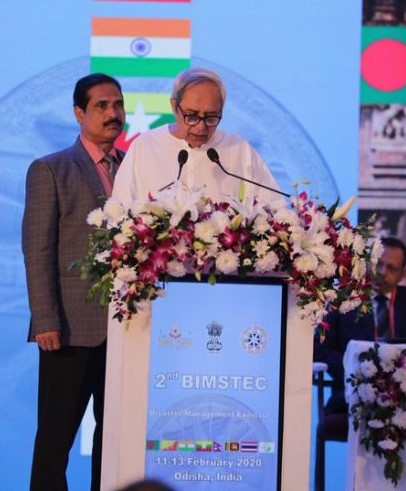OdishaPlus Bureau
Chief Minister Naveen Patnaik on Tuesday called upon BIMSTEC countries to improve their early warning dissemination system and capacity building for protection of cultural heritage sites from natural disasters.
The heritage sites must be preserved for future generations at any cost because they not only represent cultural identity of a nation but are also a driving force for the country’s economy, the chief minister said.
Patnaik said this while inaugurating the second BIMSTEC Disaster Management Exercise-2020 (BIMSTEC DMEx-2020), hosted by National Disaster Response Force (NDRF).
The Bay of Bengal Initiative for Multi-Sectoral Technical and Economic Cooperation (BIMSTEC) is an international organization of seven nations of South Asia and Southeast Asia.
The member states of BIMSTEC are Bangladesh, India, Myanmar, Sri Lanka, Thailand, Nepal and Bhutan.
Noting that the theme of the exercise is focused on restoration of heritage sites damaged in natural disasters, Patnaik said, “The BIMSTEC countries are a great repository of ancient heritage with numerous cultural heritage sites susceptible to various kinds of natural disasters.”
Substantial damages to monuments during the Gujarat earthquake in 2001 and the 2005 tremor in Nepal are a reminder of the threat to heritage sites, Patnaik pointed out.
The chief minister said, Odisha is vulnerable to calamities as the state faced more than 100 cyclones since 1891.”It is important to undertake adequate documentation, proper identification and grading of heritage sites,” Patnaik said.
NDRF Director General SN Pradhan, State DGP Abhay, Odisha Chief Secretary A K Tripathy, representatives from five member countries and other dignitaries were present at the inaugural ceremony.
While five countries- Bangladesh, India, Myanmar, Sri Lanka and Nepal – are participating in this exercise, two other member countries Bhutan and Thailand, could not make it due to travel advisories issued by their governments.
Odisha’s heritage sites must be preserved for future generations at any cost for they not only represent the state’s cultural identity but also serves as a driving force of its economy, he said.
“Odisha is prone to multiple natural disasters, especially flood and cyclone. Since 1891, more than 100 cyclones have affected the state. The 1999 Super Cyclone was a watershed moment that changed and diversified the areas of cooperation, especially in the domain of disaster management preparations. Today, Odisha is well ahead of others in preparedness,” said Patnaik.
He added Odisha was the first state that set up its own dedicated disaster response force in the country.
“We invested in preparedness, forecasting and resource management with an approach of zero-casualty. Over the years, we have developed immense maturity in the area of disaster preparedness, response and recovery,” Patnaik said.
“Today Odisha is well ahead of others in preparedness Odisha was the first state that set up its own dedicated disaster response force in India. We invested a lot in preparedness, forecasting and resource management with an approach of zero-casualty. Over the years, we have developed immense maturity in the area of disaster preparedness, response and recovery. The UN and international media have hailed our efforts in keeping the level of destructions to a minimum,” the Chief Minister remarked.
With regard to the restoration of heritage sites damaged in a natural disaster, Patnaik was of the view that it is important to undertake adequate documentation, proper identification and grading of heritage sites and stressed on improving early warning dissemination system and capacity building for the conservation of cultural heritage sites.
“I hope that the BIMSTEC Disaster Management Exercise- 2020 will prove to be a milestone in safeguarding the cultural heritage of the BIMSTEC region,” Patnaik said.























